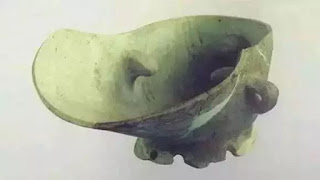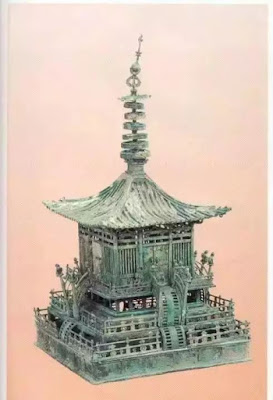64 kinds of national treasures, calligraphy and paintings and objects that China permanently bans exhibitions abroad! (Episode Three)
The introduction and sharing of the previous episode has won everyone's love. Lin Lan Painting and Calligraphy Education is your good friend, focusing on the research, teaching and inheritance of Chinese painting and calligraphy.
Episode Three
Episode Three
Episode Four
33. Jade Bianzhang
During the Shang Dynasty, the sacrificial pit of Sanxingdui No. 1 in Guanghan, Sichuan was unearthed in 1986. The whole body is decorated with patterns, vividly depicting the scenes of primitive religious sacrifices. Now in the Sanxingdui Museum.34. Money tree
Eastern Han Dynasty, unearthed in 1990 from Han Tomb No. 2 of Hejiashan, Mianyang, Sichuan. The base is made of red pottery, and the tree is cast in bronze.
35. Copper running horse
Eastern Han Dynasty. The copper running horse is also known as "Horse Stepping on Feiyan" and "Ma Chaolong Que". The bronze galloping horse is measured according to the standard scale of the good horse described in the ancient Soma Sutra. There is almost no difference in it. Therefore, some people think that it is not only an outstanding work of art, but also a French style of Soma. Now in the collection of Gansu Provincial Museum.
36. Copper Chariot
Qin Dynasty. A total of two multiplications, one in front and one in the back. After restoration, the size is about one-half the size of a real horse. The Museum of Qin Shi Huang Terracotta Warriors and Horses is now in the collection.
37. Wall plate
Mid Western Zhou Dynasty. This plate is a work during the period of King Gong in the Western Zhou Dynasty. The pan inscription is also a very beautiful calligraphy work. Its style uses concise and neat four-character sentences. This is the earliest known inscription work with a more pronounced parallel style. Now in the collection of Fufeng Museum of Zhouyuan, Shaanxi Province.
38. Chunhua Dading
In the early Western Zhou Dynasty, it was excavated from Shijiayuan in Chunhua County, Xianyang, Shaanxi in 1979. The Chunhua Great Ding is an important material for studying the distribution of Zhou people and bronze casting techniques in the early Western Zhou Dynasty. Now in the collection of Shaanxi Provincial History Museum.
39. He Zun
Western Zhou Dynasty. The whole body is based on thunder pattern, the high-relief is decorated with gluttonous patterns on the corners, and the feet are also decorated with gluttonous patterns. The craftsmanship is exquisite and the shape is majestic. It is now in the collection of the Baoji City Museum, Shaanxi.
40. Maoling Stone Carving
The large stone carving of Huo Qubing Tomb in Maoling of the Western Han Dynasty is a masterpiece of ancient carving art that is the cultural heritage of the Han Dynasty more than 2,000 years ago. Now in the collection of Shaanxi Maoling Museum.
41. Pottery stove unearthed in Hemudu
In the Neolithic Age, T243 was unearthed from the Hemudu site in 1977. There are three sturdy branches on the inner wall. The three branches are placed on both sides, and the other is placed on the back wall. A pair of semi-circular rings are arranged on the outer walls on both sides to connect with the branches on both sides as a whole. Now in the collection of Zhejiang Provincial Museum.
42. Daqin Nestorian Popular Chinese Monument
43. Dancing horse-bit cup imitation leather pouch-style silver pot
Tang Dynasty. This pot imitates the nomadic bladder-style kettle. What is amazing is the golden, strange horses that are stamped with molds on both sides of the pot body and the ventral side of the pot, protruding from the surface of the pot. According to research, this is a dancing horse. Now in the collection of Shaanxi Provincial History Museum.
44. Beast Head Agate Cup
In the Tang Dynasty, it was unearthed in Hejia Village in the southern suburbs of Xi'an in 1970. Also known as the gold-inlaid beast head agate cup, it is 6.5 cm high, 15.6 cm long, and 5.9 cm in diameter. This treasure of the country symbolizes wealth and power. It is a noble work of art. At the same time, it is also likely to be a national gift for a country in Central and Western Asia to enter the Tang Dynasty. It has an extraordinary meaning and is in the spark of the collision of Eastern and Western civilizations. An important cultural relic born. Now in the collection of Shaanxi Provincial History Museum.
45. Jingyun Bronze Bell
In the Tang Dynasty, it is a relic of the Jingyun Temple in Xi'an, Shaanxi Province, 1300 years ago. The "New Year's Bell" played by Shaanxi People’s Broadcasting Station on New Year’s Eve is the recording of Jing Yunzhong.
46. Silver Flower Two-wheeled Twelve Ring Tin Rod
In April 1987, the mysterious gate of the underground palace of Famen Temple, which had been closed for more than a thousand years, was opened, and the tin rod was discovered. Now in the collection of Famen Temple Museum.
47. Eightfold Treasure Letter
The same is unearthed from the underground palace of Famen Temple. The first part of the eightfold treasure letter is the place where the Buddha finger relic is hidden.
48. Copper Buddha
In the Tang Dynasty, the underground palace of Famen Temple was unearthed. Inside the tower is a gilt Jialing Pingjia bird-patterned silver coffin, and the fourth Buddha finger relic is inside the lid of the gilt Jialing Pingjia bird-patterned silver coffin.
Today’s first episode is here, the next episode will be more exciting, continue...
64 kinds of national treasures, calligraphy and paintings and objects that China permanently bans exhibitions abroad! (Episode Four)
Lin Lan’s calligraphy and painting education, focusing on calligraphy and calligraphy research and teaching, thank you!




































No comments: